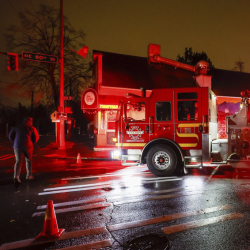 WASHINGTON (AP) -- Affluent black Americans who are leaving industrial cities for the suburbs and the South are shifting traditional lines between rich and poor, according to new census data. Their migration is widening the income gap between whites and the inner-city blacks who remain behind, while making blacks less monolithic as a group and subject to greater income disparities.
WASHINGTON (AP) -- Affluent black Americans who are leaving industrial cities for the suburbs and the South are shifting traditional lines between rich and poor, according to new census data. Their migration is widening the income gap between whites and the inner-city blacks who remain behind, while making blacks less monolithic as a group and subject to greater income disparities.
"Reverse migration is changing the South and its race relations," said Roderick Harrison, a Howard University sociologist and former chief of racial statistics at the Census Bureau.
He said a rising black middle class is promoting a growing belief among some black conservatives that problems of the disadvantaged are now rooted more in character or cultural problems, rather than race. But Harrison said most black Americans maintain a strong racial identity, focused on redressing perceived lack of opportunities, in part because many of them maintain close ties to siblings or other blacks who are less successful.
"I don't think suburban blacks are yet driven by their higher income or new locations, although this might have a greater effect in a generation or two," he said.
The typical white person last year earned income roughly 1.7 times higher than that of blacks, the widest ratio since the 1990s. Census figures released Thursday show that cities such as Detroit, Chicago, Philadelphia, Cleveland and Milwaukee in particular saw increases in inequality, hurt by an exodus of middle-class minorities while lower-skilled blacks stayed in the cities.
Low-income blacks also slipped further behind. The share of black households ranking among the poorest poor - those earning less than $15,000 - climbed from 20 percent to 26 percent over the past decade; other race and ethnic groups posted smaller increases. At the same time, African-Americans making $200,000 or more a year were unchanged from 2000 at about 1.1 percent, even after a deep recession.
Many affluent blacks are moving to the South, seeking a return to their ancestral homeland after a decades-long Great Migration to the North.
Pursuing a better quality of life, they are opting for more upscale metropolitan locales rather than the traditional rural communities of the old South in places such as Louisiana, Mississippi and Arkansas, which remain home to larger shares of minority farmers, construction and other low-wage workers.
Since 1990, blacks living in Southern urban locations such as Atlanta, Dallas, Washington, D.C., and Miami, where incomes rose in the last decade, have increased 70 percent.
The newer Southern arrivals include Marc Harrigan, 42, a physician who grew up in New York and attended college in Rhode Island. Harrigan said he knew he wanted a change once he finished medical school and married, yearning for what he saw as a more progressive culture than Hampton Roads, Va., where he practiced for a few years.
Settling on Atlanta, Harrigan described it as a good fit with affordable housing and decent schools despite the culture shift outside the immediate metro area.
"It was important that we move where there was a critical mass of African-American professionals," he said. "But in other parts of the state, I'm not sure they have embraced assimilation, if you will."
William H. Frey, a Brookings Institution demographer who did a broad analysis of the race and income data, said the latest numbers reflect a longer-term trend of increased racial integration between blacks and whites. He said the changes could pose challenges in the coming months in political redistricting as well as courting the traditional black vote.
Groups in states such as Texas, Florida, California and Maryland have gone to court or are now otherwise grappling with political maps being redrawn based on the 2010 census, considering whether to preserve historically black legislative seats amid slowing population growth and black movement into traditionally white suburbs. The change also complicates strategy for President Barack Obama, who is banking on blacks in key Southern states in the 2012 election.
Obama is pushing a broader re-election theme of middle-class renewal, reciting his jobs agenda and his feud with Congress over extending a Social Security tax cut, while targeting outreach to black communities in hopes of remaining competitive in Southern and other battleground states.
"The Democratic party will surely gain consistent support from these new black suburbanites, but the active support for traditional black issues like civil rights may take a back seat," Frey said, citing issues such as schools, housing and public safety that may rise to the forefront.
According to census data, about 67 million Americans, or nearly 1 in 4, lived in neighborhoods with poverty rates of 20 percent or higher; that's up from roughly 1 in 5 in 2000. The South in general had higher shares of people living in high-poverty areas, led by states including Mississippi, Louisiana, Texas and Kentucky.
Despite some gains for middle-class blacks, African-Americans on average last year still had rising poverty and worsening economic situations compared with whites. The mostly suburban counties where blacks had growing and higher-than-average income make up about 19 percent of the black population. That's compared with 45 percent of blacks who lived in urban counties and small towns where black incomes fell relative to whites.
Part of the income divide falls along age and education, with higher unemployment rates for young men and those who lack a college degree. Last year, about 19 percent of men ages 25 to 34 were "idle" - neither working nor attending school - up 5 percentage points from 2007, according to the Population Reference Bureau. About 31 percent of young black adults were disconnected from school and work, compared with 27 percent for Latinos and about 19 percent each for whites and Asians.
Blacks also were more likely than other groups to live in neighborhoods with poverty rates of 40 percent or more, roughly 1 in 9.
Other findings:
-Counties with the greatest income gaps between non-Hispanic whites and Latinos included New York, Chicago, Dallas, Los Angeles and the Washington, D.C., suburbs, as well as smaller, more rural counties in the South and West where the numbers of Mexican immigrants have been growing.
-Thirteen percent of Latinos and 18 percent of blacks held at least a bachelor's degree last year, compared with 31 percent of non-Hispanic whites and 50 percent of Asians. That is up from 2000, when 10 percent of Hispanics and 14 percent of blacks completed college.
-Less than half a million people speak a North American tribal language at home, compared with 60 million who speak a different language other than English and 227 million who speak English only. About 65 percent of those tribal speakers lived in three states - Alaska, Arizona and New Mexico. The most commonly spoken tribal language was Navajo, followed by Yupik and Dakota.
The figures come from previous censuses and the 2010 American Community Survey, which samples 3 million households. For places with fewer than 20,000 people, the ACS figures from 2006-2010 were averaged to help compensate for otherwise large margins of error.
---
Online:
http://www.census.gov
© 2011 The Associated Press. All rights reserved. This material may not be published, broadcast, rewritten or redistributed. Learn more about our Privacy Policy and Terms of Use.





















































































































































































































































































































































